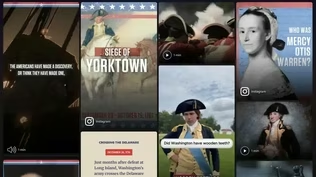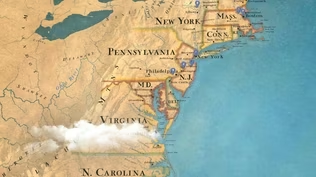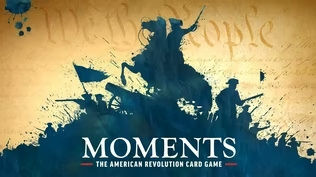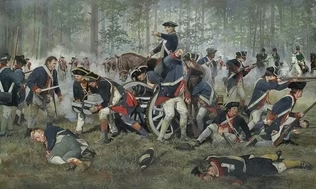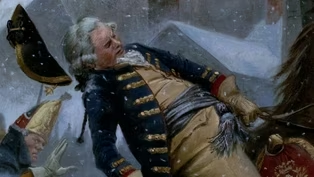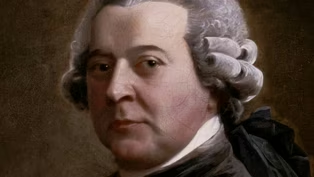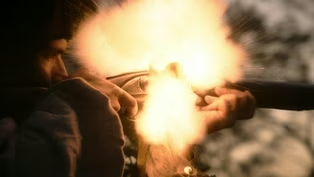
Tsi'yu-gunsini and the American Revolution on the Frontier
Clip: Episode 3 | 5m 50sVideo has Closed Captions
Cherokee chief Tsi'yu-gunsini, Dragging Canoe in English, fights against Patriot settlers.
Tsi'yu-gunsini, or Dragging Canoe in English, is a Cherokee chief who leads raids against illegal settlements by American colonists on Native lands. Their British allies urge them to be patient, but Dragging Canoe doesn't hesitate. In response, thousands of colonial militiamen pour into Native territories and wage a war of total annihilation.
Problems playing video? | Closed Captioning Feedback
Problems playing video? | Closed Captioning Feedback
Episodes presented in 4K UHD on supported devices. Corporate funding for THE AMERICAN REVOLUTION was provided by Bank of America. Major funding was provided by The Better Angels Society and...

Tsi'yu-gunsini and the American Revolution on the Frontier
Clip: Episode 3 | 5m 50sVideo has Closed Captions
Tsi'yu-gunsini, or Dragging Canoe in English, is a Cherokee chief who leads raids against illegal settlements by American colonists on Native lands. Their British allies urge them to be patient, but Dragging Canoe doesn't hesitate. In response, thousands of colonial militiamen pour into Native territories and wage a war of total annihilation.
Problems playing video? | Closed Captioning Feedback
How to Watch The American Revolution
The American Revolution is available to stream on pbs.org and the free PBS App, available on iPhone, Apple TV, Android TV, Android smartphones, Amazon Fire TV, Amazon Fire Tablet, Roku, Samsung Smart TV, and Vizio.

MOMENTS: The Revolutionary War Card Game
Use your knowledge of Revolutionary-era moments to build a timeline of real historical events.Providing Support for PBS.org
Learn Moreabout PBS online sponsorship[Insects chirping] Voice: It seems to be the intention of the White people to destroy us as a people, but I have a great many young fellows that would support me, and we are determined to have our land.
Tsi'yu-gunsini.
♪ Narrator: In the summer of 1776, Cherokee warriors led by Tsi'yu-gunsini, "Dragging Canoe" in English, began attacking frontier settlements west of the Appalachians on land now claimed by Virginia and the Carolinas.
The Royal Proclamation of 1763 had expressly barred colonists from purchasing or moving onto Indian lands west of the Appalachians, but British officials had been powerless to enforce it or to keep some Native Americans, including Dragging Canoe's own father, from leasing or selling land to settlers and speculators.
Kathleen DuVal: We think of the Revolution as a war against empire, but it very quickly becomes a war for empire.
One war aim of the American Revolution is to take the Ohio Valley and the South.
That's what Americans wanted.
The British government had kept them from taking Native lands, so for the Shawnees and the Delawares, Cherokees, and many other people, the American Revolution was a war to protect these places against an enemy they already knew quite well.
Voice: Our Shawnee nation, from being a great people, are now reduced to a handful.
The red people, who were once masters of the whole country, hardly possess ground enough to stand on.
The lands where but lately we hunted are now thickly inhabited and covered with forts and armed men, and wherever a fort appears, there will soon be towns and settlements.
[Shawnee Delegate] DuVal: In May 1776, a delegation of Shawnees, Delawares, Anishinaabe, and Haudenosaunee came to the Cherokee town of Chote.
They said, "Enough is enough.
"We've had year after year "of illegal settlement coming onto our lands.
"Now a war has come "that has divided those settlers from their government.
This is the time to strike."
Voice: It is better to die like men than to diminish away by inches.
The Cherokees have a hatchet.
Take it up and use it immediately.
[Shawnee Delegate] Narrator: British agents still in Indian country, who had armed the Cherokees to fight the rebels, now urged them to be patient and wait until British troops could join them.
Dragging Canoe would not listen to the British or to the elders of his father's generation, who had urged diplomacy.
He rallied the young men and went to war.
[Flames crackling] They killed and scalped settlers in the Carolina and Virginia backcountry, burned their cabins and crops, and drove off their livestock.
Colin Calloway: The result is, as the older chiefs feared it would be, that those American colonies immediately send armies into Cherokee country.
Some of the American leaders actually say in as many words, "This is just what we were waiting for.
"Now we have justification "for launching a full-scale assault on the Cherokees and to drive them out and take their land."
♪ Voice: Nothing will reduce those wretches so soon as pushing the war into the heart of their country, but I would not stop there.
I would never cease pursuing them while one of them remained on this side of the Mississippi.
Thomas Jefferson.
♪ DuVal: There are thousands of militiamen in South Carolina, North Carolina, Virginia, Georgia ready to join the Revolution, ready to fight Britain, but the British aren't there.
There are no British there to fight.
Who's there to fight?
The Cherokees.
Narrator: Some 6,000 militiamen stormed through Cherokee country.
They destroyed 36 towns, including Dragging Canoe's own village.
Philip Deloria: This is meant to be instructive to other tribes.
"If you think you're gonna keep a British alliance, "guess what we're gonna do?
"We're gonna come and burn everything.
"We're gonna destroy your fields.
"We're gonna destroy your corn.
"We're gonna destroy all your stored-up food.
"We're gonna wage total war on those people.
Let's teach all Native people a lesson about what's coming."
♪ Narrator: In the end, older Cherokee leaders would sue for peace and be forced to cede another 5 million acres.
Maggie Blackhawk: The colonists wanted to possess that land exclusively, and it's a vision that is Western, as contrasted to Native people, who had a more spiritual or more engaged relationship to land.
Narrator: Unlike his elders, Dragging Canoe would not surrender.
With hundreds of men and their families, he managed to escape westward to settle along the Chickamauga Creek in what is now Tennessee, where he remained defiant.
"I could not hear their talks of peace," Dragging Canoe said.
"My thoughts and my heart are for war."
The Battle of Long Island (Brooklyn)
Video has Closed Captions
Clip: Ep3 | 6m 10s | General Clinton ambushes George Washington in the largest battle of the American Revolution. (6m 10s)
Video has Closed Captions
Clip: Ep3 | 6m 44s | Washington devises a bold plan to cross the Delaware River and attack Trenton on Christmas night. (6m 44s)
Democracy & The Adoption of the Articles of Confederation
Video has Closed Captions
Clip: Ep3 | 6m 14s | The Continental Congress meets to debate and adopt the Articles of Confederation. (6m 14s)
Preview: The Times That Try Men’s Souls
Video has Closed Captions
Preview: Ep3 | 30s | Washington abandons New York City and flees across New Jersey, before attacking Trenton. (30s)
Warpath of Nations: The Naval Battle That Prevented a Canadian Invasion
Video has Closed Captions
Clip: Ep3 | 5m 48s | Horatio Gates and Benedict Arnold rush to stop the British sailing down Lake Champlain. (5m 48s)
Video has Closed Captions
Clip: Ep3 | 5m 24s | The British assault Breed's Hill and Bunker Hill near Boston in the bloodiest battle of the war. (5m 24s)
Providing Support for PBS.org
Learn Moreabout PBS online sponsorshipSupport for PBS provided by:
Episodes presented in 4K UHD on supported devices. Corporate funding for THE AMERICAN REVOLUTION was provided by Bank of America. Major funding was provided by The Better Angels Society and...

